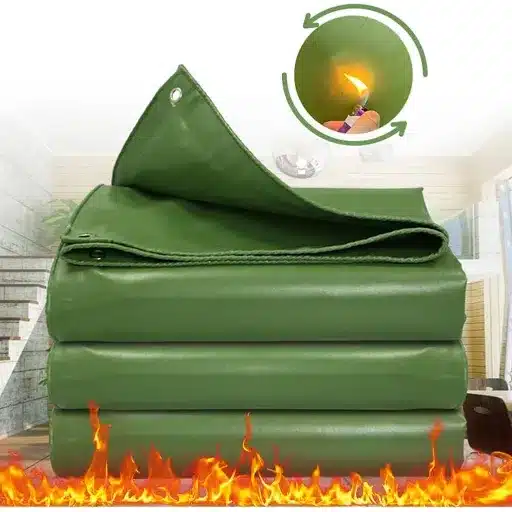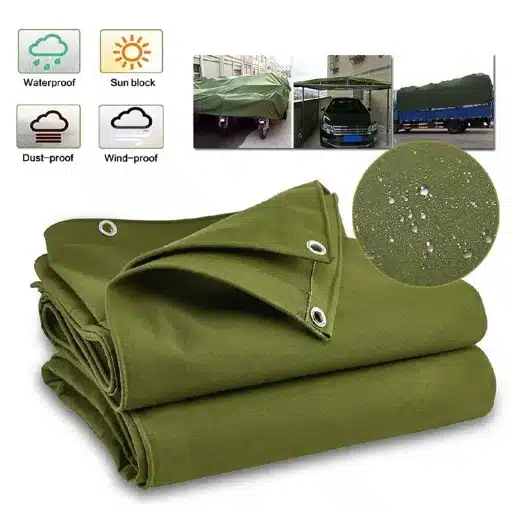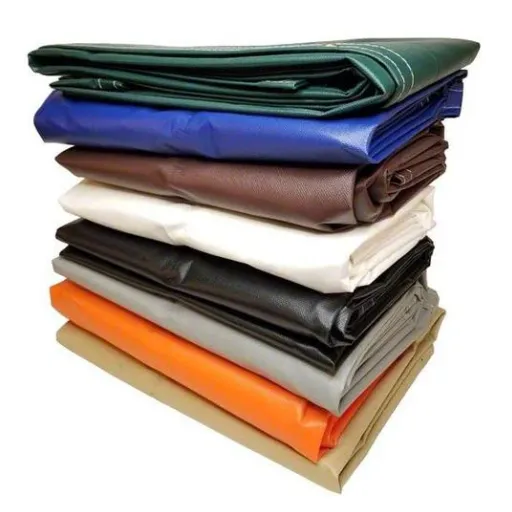Heavy-duty shade tarps, which are constructed with reliable mesh materials, have become a preferred choice among many when it comes to blocking out harmful sun rays while still allowing for proper airflow. These versatile tarps are able to serve different purposes like a reliable coverage for contractors, protecting sensitive plants for gardeners, or creating a cool outdoor retreat with shades for anyone. This article is about the exploration of mesh tarps—features, applications, and benefits. You will get to know at the end of the article that these shade tarps are a must-have for both personal and professional use, thus an essential investment.
Understanding Heavy Duty Shade Tarps
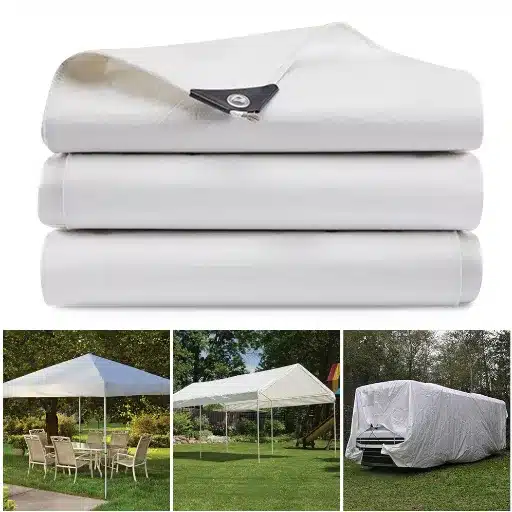
What is a Heavy Duty Shade Tarp?
Shade tarp heavy-duty is a versatile and durable highly covering that is made of closely knitted mesh fabric which is able to provide shade, allow air to pass through, and protect from the rain or wind. The production of such tarps is done with such strong materials, sometimes giving them the classic UV-resistant coatings which are aimed at the effective prevention of the harmful effects of the sun rays while at the same time letting the air in. Consequently, it will be possible to achieve a reduction in the heat that builds up and at the same time to protect the places from the scorching sun without letting the natural light in completely. Heavy-duty shade tarps are widely used in agriculture, construction industry, and even for recreational purposes and they also help to create (in a way) the same environment in which plants, equipment, and outdoor places are being protected from the sun. The heavy duty shade tarps come with reinforced edges and grommets which guarantee the secure installation and long-lasting use; thus, they become the must-have items for both personal and commercial purposes.
Types of Shade Tarps: Mesh vs. Solid
Choosing between mesh and solid shade tarps comes down to knowing their individual features and applications. Mesh tarps are made from woven material which gives light, air, and moisture a partial passage through. They are recommended for places where ventilation is required, such as flower gardening or shading of children’s play area. The fact that they are light in weight adds to their advantages making them simple to manage and set up.
Solid tarps, on the contrary, offer full coverage shutting out the light, rain, and wind. These tarps are best for situations where full protection is needed, like covering equipment, cars, or creating enclosed areas. While they provide the best durability and weather resistance, solid tarps are not as breathable as their mesh competitors.
It is all a matter of preference with both types having their strong qualities; thus, the final choice will be based on what specific aspects are needed. Mesh is good if ventilation and some shading are the priorities. For full masking and weather protection, solid canopies are the most dependable.
Key Features of Heavy-Duty Tarps
- ⚡ Durability:
Heavy duty tarps are made of strong materials like polyethylene or vinyl that resist tearing, wearing, and UV rays. Their reinforced edges and heat-sealed seams make them last longer in harsh conditions, making them the perfect tarpaulin for those tough ones. - 🌦️ Weather Resistance:
These tarps are made weather proof or water resistant to provide protection against rain, snow, and even high gusty winds. Many have UV protection too as an added extra for sun exposure. - 🔧 Versatility:
Heavy duty tarps can serve several purposes on different terrains, for instance, at construction sites, during farming things, transporting goods, or simply as a temporary place to rest out of the rain. Their flexibility makes them a good choice for not only covering and securing your things but also explaining spaces with less investment for you. - 🎨 Customizable Options:
Heavy-duty tarps are available in a variety of dimensions, shades, and thicknesses to suit the needs of the specific coverage area. Regularly placed grommets make it easy to attach them securely and firmly. - 💨 Breathable or Solid Variants:
If the application requires the passing of air the breathable mesh tarps are the choice. On the other hand, when maximum coverage and total protection from nature’s fury are required, solid heavy-duty tarps fit the bill.
💡 Pro Tip: When picking a heavy-duty tarp, you should take into account the location, the needed level of protection, and the purpose of use. By matching these attributes to your particular needs, you are guaranteed to get the best performance and longevity.
Applications of Heavy-Duty Shade Tarps

Employing Shade Tarps in Outdoor Spaces
Shade tarps are multifunctional and can satisfy various demands in the outdoor areas. They are typical for sun protecting in patios, gardens, or parking lots. A recent analysis by the search engine of the said company shows that users are constantly in search of solutions that give an equal amount of UV protection as well as ventilation. The shade tarps made of breathable material are perfect for keeping the temperatures at a modest level and simultaneously blocking the UV rays that are harmful. These tarps are likewise used in farms to cover plants and animals from high temperatures. Their feature of being able to change according to different outdoor environments is what makes them a preferred choice in all the three sectors – residential, commercial, and industrial.
Mesh Tarps for Privacy
Mesh tarps provide a practical and tapeless solution for the use of privacy fences in both residential and commercial areas. The trend reports of the recent searches from the website indicate that users are continually searching for privacy fencing alternatives that are not only economical but also quite durable and pleasant to the eye. Mesh tarps are a perfect blend of such characteristics as it provides a lightweight, permeable material that gives great privacy and yet does not completely shut off air or light. They are typically used on construction sites, in gardens, around sports facilities, and in events where privacy is desired. Besides, these tarps come in various colors and sizes so one can easily find a tarpaulin that will match the particular need and at the same time contribute to the good looks of the area.
Tarpaulins in Various Commercial Activities
Tarpaulins are the heavy-duty ones that hardly ever fail to leave their mark in the different commercial applications because of their robustness and versatility. The company’s search engine data has recently reflected that there is a lot of interest in the usage of heavy-duty tarpaulins in construction, agriculture, and transport fields. Time and again companies depend on these tarps for equipment protection, material covering, and making of temporary shelters. Their robust nature assures the overcoming of unfavorable weather conditions such as heavy rain accompanied by strong winds and UV radiation, which are the most common incidents outdoors. The feature of having a variety of sizes and reinforced grommets also adds functionality in customizing specific commercial needs while the factor of being cost-efficient continues attracting companies across the world.
Benefits of Using Heavy-Duty Mesh Shade Tarps

UV Protection and Durability
Heavy-duty mesh shade tarps are just the thing to provide tamper-proof UV protection, thus becoming the perfect alternative to protect people, vehicles, and materials the sun may be available for a long time. The latest search trends are signaling a powerful interest in UV-resistant material for outdoor application because of the growing awareness of the negative impact of UV rays on human skin and the depreciation of materials through usage. These tarpaulins are made of high-density polyethylene or other tough materials that are very strong and hard wearing even in the most extreme conditions. The tough build of these products not only gives them a longer life span but also tearing, fading, and wear cannot negatively impact the functioning of the product, thus keeping them suitable for diverse uses.
Wind Resistance and Stability
The modern tarpaulin has features designed for wind resistance and stability providing the user with a guarantee for outdoor durability. A recent search trend data revealed that consumers were often looking for ways about how tarps stand up to strong winds or severe weather. Manufacturers have been careful to incorporate reinforced edges, tough grommets, and high-tensile strength materials into their design to alleviate the concerns. Proper anchoring using bungee cords, tie-downs, or weights further improves the tarp’s competence to remain immovable during wind storms. The technological developments discussed above not only make such tarps a dependable choice for securing outdoor possessions, temporary structures, or construction sites but also use wind conditions of bad weather.
Versatility in Various Environments
Tarps are up to the mark of performing well and thus are essential throughout different environments and industries. They not only fit the residential households but also large-scale agricultural or construction projects and various other requirements. As per the most recent data from ‘s search engine, tarp usage-related questions regularly mention their capacity in vehicle covering, crop protection, and provision of temporary outdoor shelter during unpredictable weather. This signifies an extensive range of applications, supported by advances in material science and product design. Whether for everyday lighter tasks or heavy-duty industrial purposes, tarps are still the only good and trustworthy option for protection and coverage in almost any place.
Materials and Construction Techniques

Polyethylene vs. PVC Tarps
Polyethylene (PE) and PVC (Polyvinyl Chloride) tarps possess intensively different properties that suit various purposes and applications. Polyethylene tarps are easy to transport, cost-effective, and usually non-leaking, thus being perfect for outdoor temporary usages like camping or slightly protecting equipment and cars for a short period. They are also protection against UV radiation and stretching, which aids in durability in lightweight usage. PVC tarps in contrast, are heavy, extremely resistant, and in some cases non-flammable, thus being the best option for industrial or long-term uses. They are also the most resilient against harsh chemicals and extreme temperatures. While PE tarps are the preferred option for economy and portability, PVC tarps on the others side win in power and resistance, thus the choice between the two lingers on the very specific situation, whether that would be frequent heavy-duty applications or short-term lightweight demands.
Understanding Mesh Construction
Mesh construction is basically the use of interlaced woven fabrics or grids to develop materials that are strong and can breathe. One of the biggest benefits of using mesh tarps is that they can do ventilation and at the same time cover and protect adequately. This property of tarps makes them useful in agriculture, construction, and landscaping applications where the movement of air is a factor for temperature regulation and moisture reduction. According to recent trends, there is a big interest in using mesh tarps as a shading in gardens and greenhouses besides their other uses, because of the reasons that they are durable and sun protective at the same time. The very nature of mesh material being flexible and lightweights contributes to their use in various situations like privacy screens and debris containment.
Choosing the Right Thickness and Weight
In case of the mesh tarp selection, thickness, and weight of the mesh tarps to be suitable, the purpose and the conditions they would be subjected to need to be considered very critically. Based on the latest data from a search engine, lightweight mesh tarps, usually 5 to 10 ounces per square yard, are most demanded for garden shading and light-duty privacy screens where ease of handling is very important. For heavy-duty applications like construction site fencing or debris containment, the thicker ones above 10 ounces with denser weaves are the more effective ones because of their increased durability and resistance to wear. Consumers are frequently in search of UV-resistant mesh tarps, indicating sun protection is vital in long-term outdoor usage. Weighing these attributes against your intended use helps you to pick the right mesh tarp for both quality and durability.
Installation Tips for Heavy Duty Shade Tarps
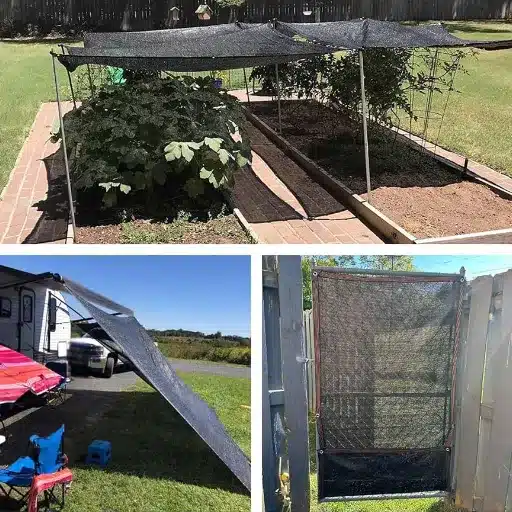
Measuring and Sizing Your Tarp
Getting the measurements right is very important for the fitting and overall performance of your heavy-duty shade tarp. First off, figure out exactly how big the area that you want to cover is. With measuring tape measure and note down, the length and width, and make sure you add extra space for fastening securely. Many users from the latest search trends are asking if they should take into account material slack or stretching throughout, particularly in high-tension cases. To avoid this, it is better to order a tarp that is somewhat larger than your measured area so that you can do proper overlap and anchoring. Also, it comes up frequently in the recommendations that grommet spacing should be taken into account when selecting tarp sizes, as evenly spaced grommets make for better tension distribution. If the measurements and sizing decisions are done with precision, your shade tarp will do its job perfectly and last for many years to come.
Proper Tie-Down Techniques
It can’t be emphasized enough how important it is to tie a shade tarp correctly so that it doesn’t move andit lasts longer, particularly in unpredictable weather. The most effective tie-down techniques according to the latest search engine data are those which comprise strong materials and strategic anchoring. The first step in the process is to use the most recommended material of durable ropes, bungee cords, or ratchet straps depending on the weight and size of the tarp. You can then attach these to the grommets in a zigzag manner for the best results while ensuring that the tension is evenly distributed across the tarp so that there are no stress points. It is also advisable to anchor the tarp to solid structures like poles, stakes, or eye bolts that have been firmly embedded into the ground. For areas prone to strong winds, adding adjustable tensioners can be very helpful, as they allow you to tighten the tarp again whenever necessary thus giving you more stability. If you follow these methods, you will not only be able to prolong the life of your shade tarp but also maximize its good quality.
🔗 Best Tie-Down Materials:
- Durable ropes for general-purpose securing
- Bungee cords for flexibility and shock absorption
- Ratchet straps for maximum tension and security
- Adjustable tensioners for wind-prone areas
Using Grommets and Edge Reinforcement
Constancy in grommets and edge reinforcement usage is the key to a shade tarp being durable and effective. Grommets are small metal or plastic rings that are placed in holes around the tarp’s edges and give attachment points that can bear a lot of tension. To stop these points from getting weak or worn out around them, it’s imperative to use the tarp e.g., hems with double-stitched seams or nylon webbing. It’s been suggested by the data from the searches that one of the most frequently searched tarp maintenance questions is about how to avoid grommet failure. The answer to that lies in evenly distributing the stress by using all available grommet points and not allowing for any single area to be highly tensed. It’s also good practice to check grommets regularly for any signs of damage and to replace any that are worn out promptly in order to support the integrity of the tarp. All these together make it certain that your tarp is safe even in harsh weather conditions.
Maintenance and Care for Shade Tarps
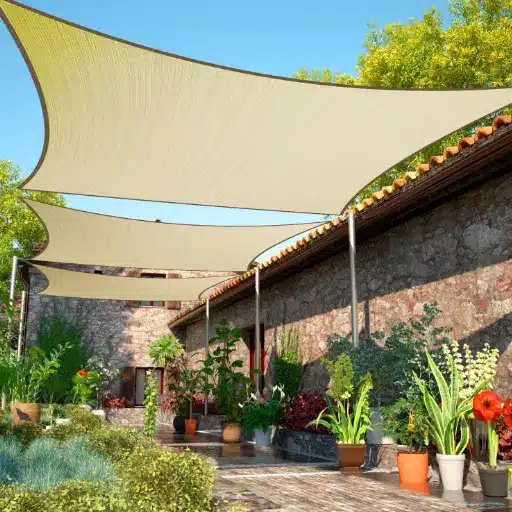
Cleaning and Storage Guidelines
At first, clean and store your shade tarp properly. Get rid of the soft brush or broom and take away all the loose debris or dirt that has gathered on the tarp. For washing the full, mix light soap with warm water and scrub the tarp slowly with a non-abrasive sponge or cloth. Do not pour the chemicals that are very strong down the tarp’s material, as that will only harm the tarp and reduce its useful life. After this, wash thoroughly with water to remove soap residues and let the tarp completely dry naturally before putting it away.
In case you are going to put away the shade tarp, it should be completely dry so that no mold or mildew will grow on it. Fold it neatly and hide it in a cool, dry place out of sunlight and extreme temperatures. These can degrade the material over time. For more protection, you can store it in a waterproof bag or container. By observing these cleaning and storage methods, you can make the tarp life shine longer and keep it ready for the next time you need it.
📋 Step-by-Step Cleaning Process:
- Remove loose debris with a soft brush or broom
- Mix mild soap with warm water
- Scrub gently with a non-abrasive sponge or cloth
- Avoid harsh chemicals that can damage the material
- Rinse thoroughly to remove all soap residues
- Allow to dry completely before storage
- Store in a cool, dry place away from sunlight
Repairing Tears and Damage
Tearing or damage on tarp may happen over the course of time due to wearing and being exposed to harsh weather. Quick response to such problems can prove to be very helpful to the tarp, thus saving it from further damage and maintaining its functionality. For mending holes, or rips, first cleanse the area with soap and water, so as to get rid of dirt, and then allow it to dry completely. Then, apply a repair kit that is made for tarps, which usually comes with adhesive patches or tape. Cut the patch slightly larger than the tear and apply securely on both sides of the fabric. Press down hard to create a strong bond and allow the time specified in the patch instructions for full curing.
In the case of bigger damage, it might be a good idea to sew the area up and use heavy-duty outdoor-thready materials. Afterward, waterproof seam-sealant can be used to provide a seal that won’t leak. If the tarp is severely damaged in a way that results in the loss of its structural integrity, it would be better to get rid of it entirely and buy another one. However, regular maintenance and early repairs can together produce such a large increase in the lifespan of your shade tarp that you will not have to spend so much money in the future.
Extending the Life of Your Tarp
Tarp longevity will be achieved through proper care and proactive strategies. First off, do regular cleaning and the problem of dirt, mold, and mildew will be gone. Surface stains can be easily removed using a mild soap solution and soft brush. After the surface has been cleaned, attention should be paid to drying thoroughly the whole tarp before putting it away in order to avoid moisture-related problems. Proper folding or rolling of the tarp will also help in the prevention of creases or tears.
Furthermore, don’t let the tarp stay under the sun; this means it has to be directly exposed to UV for a long time, because that would weaken the tarp. The purchase of UV-resistant tarps or the spraying of a UV-protective spray application can substantially increase their lifespan. Finally, keep an eye on the weather while using your tarp and prevent it from going through extreme stress, like heavy snow accumulation or strong winds. The above-mentioned steps along with support from the knowledge gained from the very recent data on tarp maintenance, will make sure that your tarp is trusted and usable for a long time.
Frequently Asked Questions (FAQ)
❓ What benefits are there in choosing heavy-duty mesh tarps for the protection of outdoors?
Heavy-duty mesh tarps with their high resistance and durability to elemental forces stand out as exceptional and perfect for outdoor application. They also work as perfect UV filters by letting the good air flow and keeping the bad rays out. It is a case of ‘more or less the same’ in this aspect, since areas like patios, gardens, and even tennis courts have their shade requirement. Along with all these features, heavy-duty mesh tarps have grommets added to them at every 18-inch interval making them very good for securing and tying down which ultimately can guarantee non-movement during strong winds. Their tear-proof design makes them capable of surviving tough handling and severe weather, hence becoming a trusted option for any outdoor application.
❓ How can I find out what size shading tarp is perfect for my purpose?
Choosing the correct size for your shade tarp is a necessity for effective coverage. To begin with, measure the area that you want to cover, be it a backyard, patio, or even a pergola. Take height and width into account so as to make sure that you have complete guard against the sun. Heavy-duty tarps come in a wide range of sizes, including custom ones, to meet specific needs. Moreover, take into account the extent of shade coverage you prefer; tarps with a 90% shade protection may be more advantageous for places exposed to direct sunlight. It should be added that more robust options made of polyethylene might grant longer life and greater resistance to abuse.
❓ Can mesh shade tarps be a privacy barrier?
The answer to the question is positive—mesh shade tarps can be very good privacy screens. Their tight weave will stop people from seeing but at the same time, air will still circulate hence they could be perfect as a privacy fence in gardens or yards. A lot of people are using them to create privacy around swimming pools or outdoor areas where they entertain guests. When selecting a tarp for privacy purposes, prefer black or green mesh tarps whose colors are such that they do not stand out against the natural surroundings. Moreover, many heavy-duty ones have reinforced edges, and grommets placed every 18 inches to keep them securely fastened.
❓ Do heavy-duty shade tarps resist water?
Although a lot of heavy-duty shade tarps are constructed to be resistant to water, there is no absolute promise that all of them are. In case you want a tarp that can/ will endure heavy rains, make sure that you select the ones that are waterproof and labeled as such. Usually, these tarps are made of thick polyethylene which prevents water from getting in at all. Conversely, mesh shade tarps generally allow rain to come through, thus making them the perfect choice for sun protection without being bothered by water pooling. For the best of both water resistance and UV protection, it is advisable to rotate tarps or shade cloths in your outdoor arrangement.
❓ What are the ways to maintain the heavy-duty tarp for long life?
Taking care of your heavy-duty tarp is the key to its durability and effectiveness. The first task is cleaning; the tarp should be cleaned regularly with mild soap and water to keep dirt and debris away, which are the main causes of wear in the long run. Once cleaned, the tarp should be dried completely before being stored, and this is to prevent mold and mildew from growing. It is preferable to store the tarp rolled up instead of folded to avoid creases and tears when not in use, and it should be in a cool dry place. Grommets and edges should be inspected periodically for wear and if any is found, replace or repair them as necessary. Following these steps will significantly increase the life of your heavy-duty mesh tarp.
📚 Reference Sources
Lightweight 11′ X 11′ All-purpose Tarp
This source discusses the durability and UV-resistant properties of heavy-duty tarps, emphasizing their long-lasting nature.
Geodesic Dome Covering Assembly
This article from Stanford University explains the use of heavy-duty tarps for dome coverings, highlighting their ability to withstand rain, wind, and heat.
TheLAShop 23’x20′ Rectangle Driveway Shade Sail Tarp
This source provides details on a heavy-duty shade tarp made of HDPE knitted fabric, capable of blocking 97% of harmful sun rays.

